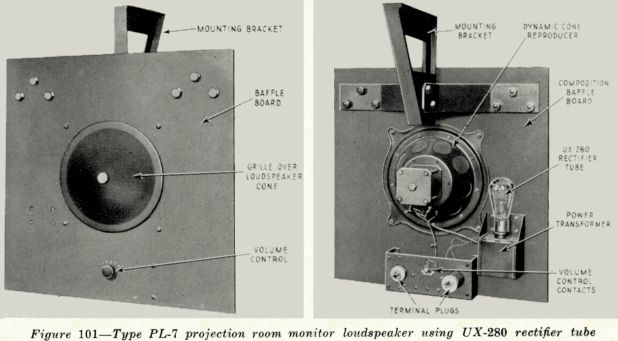|
All monitors are mounted about six feet from the floor of the projection room and usually so they are
best heard in the space between the projectors. The ideal location is on the end wall to the left of the
projectionist when facing the front wall.
152. Phasing of Loudspeakers.-It has been mentioned that the coil moves in a certain direction when
both the field current and voice coil current are in given directions. It can therefore be seen that when
more than one stage speaker is used, they must be matched so that all field coils are polarized the same
and all voice coils are "in phase." This means that their connections must be made so that at any
instant the current in all the voice coils is in the same direction. If any field or voice coil connections
were reversed, so that two speakers were not in phase, one cone would be moving in while the other
moved out when reacting to one particular current impulse. This would produce interference at the line
of intersection of the
sound beams from the two speakers, and a "dead spot" would result. The speakers have been properly
phased at the time of installation, and it is important that none of the connections are ever reversed.

(B) DIRECTIONAL BAFFLES
153. Construction.- All dynamic speakers, with the exception of projection booth monitors, are used in
conjunction with a directional baffle, which is a large funnel-shaped wooden form. This unit is six feet
long, constructed of soft pine onequarter of an inch thick. The small end, where the dynamic speaker
unit is fastened to it, is ten inches square, and this expands until the other end is about three by five
feet. Figure 102 shows the type of construction and shape of this unit, as compared in size to the
dynamic loudspeaker. Acoustic conditions in the average theatre are such that conditions are best met
by the use of such a sound directing device.
6
|

